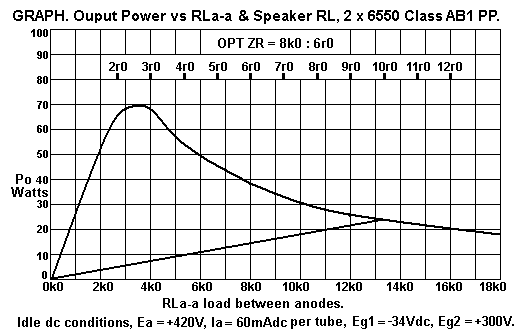| Class A1 PP tubes |
Idle Pda + Pdg2 = 0.7 x rated max Pda 1 tube, Watts |
Pda only, 1 tube Watts |
Idle Ea, +Vdc |
Idle Iadc, mAdc |
Eg2 +Vdc min'm |
Ig2 mAdc |
RLa-a = 1.9 x Ea / Iadc ohms r |
Class A1 Max Po at anodes, Watts, THD 1%, |
Class A Anode max efficiency % |
| 2 x 6550 |
29.4W |
27.4W |
300V |
91mA |
250V |
8mA |
6,333r |
25.6W |
47% |
| 2 x 6550 |
29.4W | 27.2W |
325V |
83mA |
275V |
8mA |
7,439r |
25.6W |
47% |
| 2 x 6550 | 29.4W | 27.0W |
350V |
77mA |
300V |
8mA |
8,750r |
25.3W | 47% |
| 2 x 6550 | 29.4W | 27.0W |
375V |
72mA |
300V |
8mA |
10,178r |
25.0W | 46% |
| 2 x 6550 | 29.4W | 27.0W |
400V |
66mA |
300V |
8mA |
11,515r |
25.0W | 46% |
| 2 x 6550 | 29.4W | 27.0W |
433V |
61mA |
325V |
7mA |
13,487r |
25.1W | 46% |
| 2 x 6550 |
29.4W |
27.0W |
467V |
57mA |
325V |
6mA |
15,566r |
25.3W | 46% |
| 2 x 6550 |
29.4W | 27.0W |
500V |
54mA |
350V |
6mA |
18,270r | 24.7W |
45% |
| Class A1 tubes |
Idle Pda + Pdg2 = 0.7 x rated max Pda 1 tube, Watts |
Pda 1 tube only, |
Idle Ea +Vdc |
Idle Iadc mAdc |
Eg2 +Vdc min'm |
Ig2 mAdc |
RLa-a = 1.9 x Ea / Iadc ohms r |
Class A1 Max Po at anodes, THD 1%, Watts |
Class A1 Anode max efficiency, % |
| 2 x KT120 | 40.0W |
36.9W |
300V |
123mA |
250V |
10mA |
4,634r |
35.0W |
47% |
| 2 x KT120 | 40.0W | 36.7W | 325V |
113mA |
225V |
10mA |
5,465r |
34.8W | 47% |
| 2 x KT120 | 40.0W | 36.4W |
350V |
104mA |
250V |
10mA |
6,394r |
34.6W | 47% |
| 2 x KT120 | 40.0W | 36.4W |
375V |
97mA |
275V |
10mA |
7,345r |
34.5W | 47% |
| 2 x KT120 | 40.0W | 36.0W |
400V |
90mA |
300V |
10mA |
8,444r |
34.2W | 47% |
| 2 x KT120 | 40.0W | 35.9W |
433V |
83mA |
325V |
9mA |
9,912r |
34.1W | 47% |
| 2 x KT120 | 40.0W | 35.9W |
467V |
77mA |
350V |
9mA |
11,523r |
34.1W | 47% |
| 2 x KT120 | 40.0W | 36.0W |
500V |
72mA |
350V |
8mA |
13,194r | 34.2W | 47% |
| Class A1 PP tubes KT66 or EL34 or 6AC7 or 6L6GC |
Idle Pda + Pdg2 = 0.7 x rated max Pda 1 tube, Watts |
Pda only, 1 tube Watts |
Idle Ea, +Vdc |
Idle Iadc, mAdc |
Eg2 +Vdc min'm |
Ig2 mAdc |
RLa-a = 1.9 x Ea / Iadc ohms r |
Class A1 Max Po at anodes, Watts, THD 1%, |
Class A Anode max efficiency % |
| 2 x KT66 |
20.0W |
18.1W |
275V |
66mA |
250V |
7mA |
7,916r |
17.2W |
46% |
| 2 x KT66 | 20.0W |
18.0W |
300V |
60mA |
250V |
6mA |
9,500r |
17.1W |
47% |
| 2 x KT66 |
20.0W | 17.9W |
325V |
55mA |
275V |
6mA |
11,227r |
17.0W |
47% |
| 2 x KT66 | 20.0W | 17.9W |
350V |
51mA |
300V |
6mA |
13,039r |
17.0W | 47% |
| 2 x KT66 | 20.0W | 17.7W |
375V |
47mA |
300V |
6mA |
15,159r |
16.7W | 47% |
| 2 x KT66 | 20.0W | 17.6W |
400V |
44mA |
300V |
6mA |
17,272r |
16.7W | 47% |
| 2 x KT66 | 20.0W | 17.7W |
433V |
41mA |
325V |
5mA |
20,065r |
16.8W | 47% |
| 2 x KT66 |
20.0W |
17.3W |
467V |
37mA |
325V |
5mA |
23,981r |
16.4W | 47% |
| 2 x KT66 |
20.0W | 17.5W |
500V |
35mA |
325V |
5mA |
27,143r | 16.6W |
47% |
